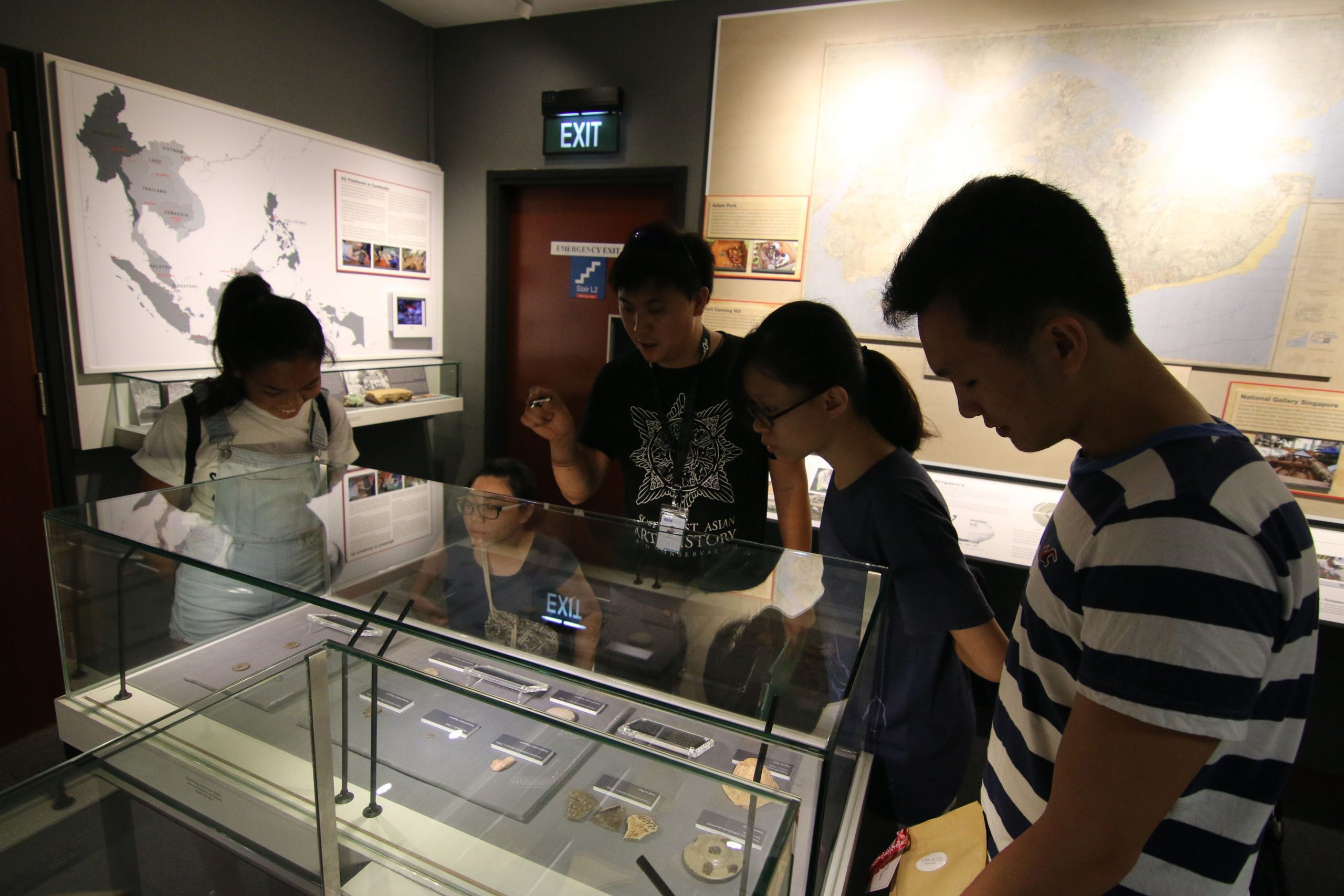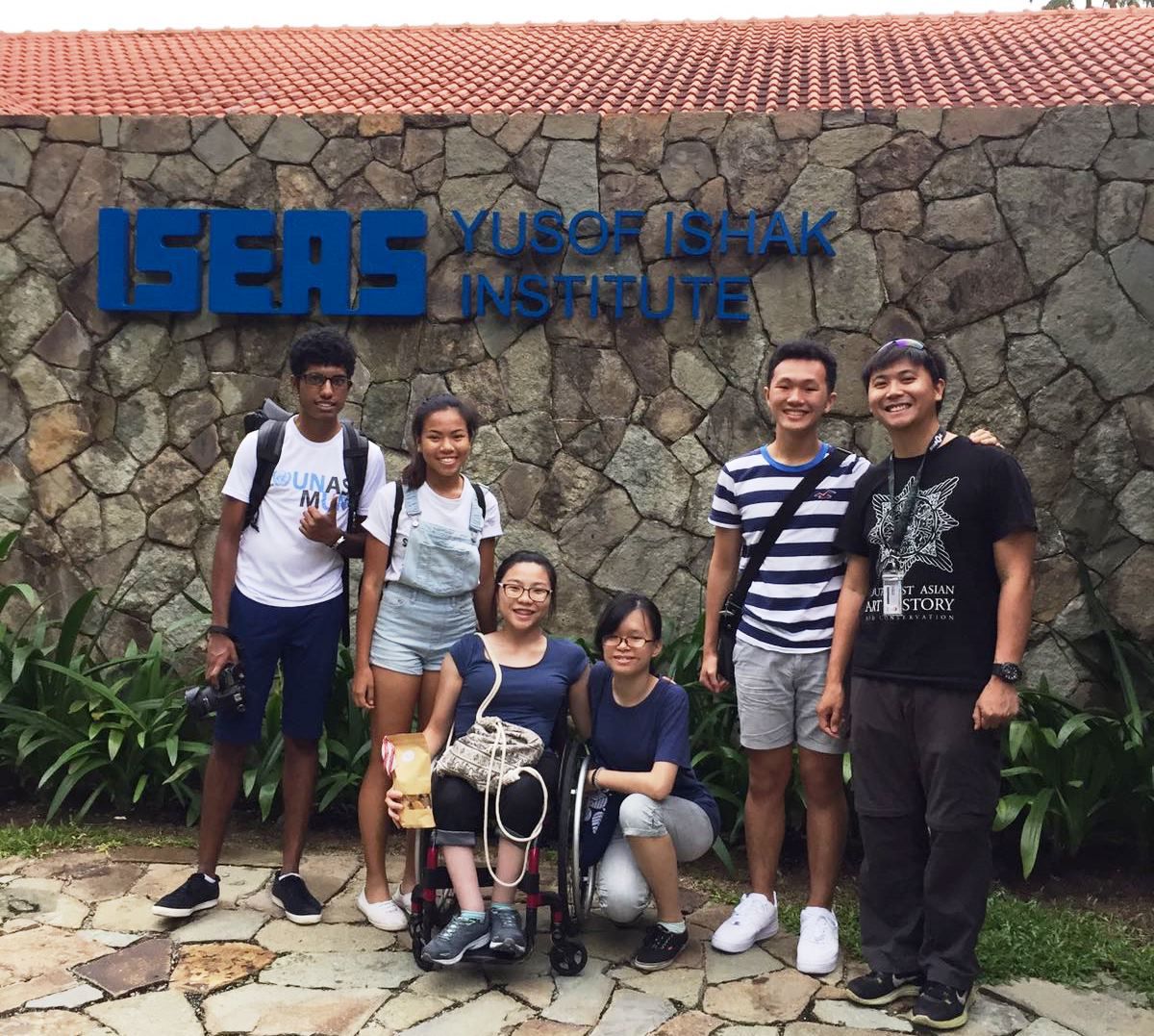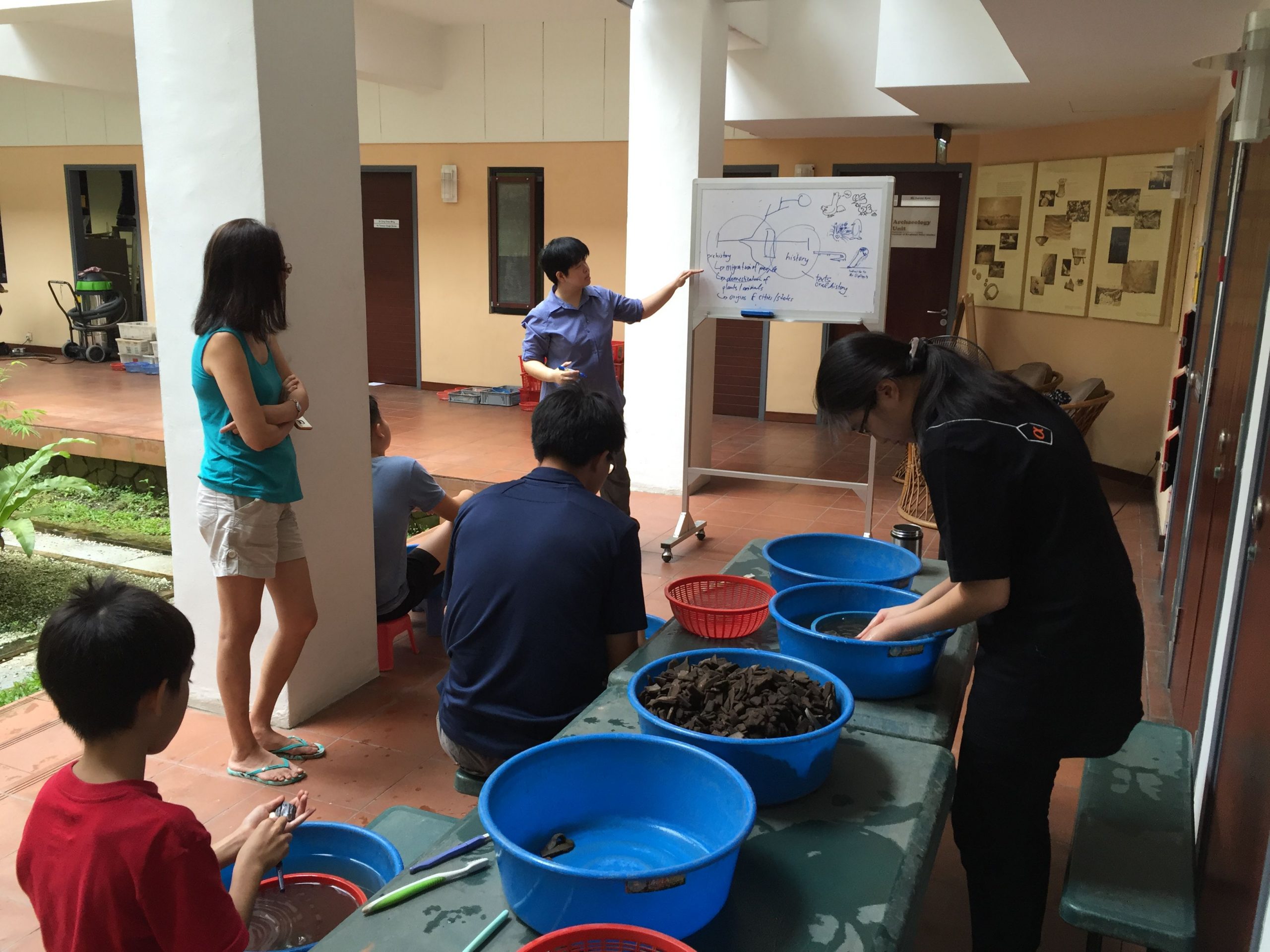NSC Field School in Trawas, East Java
July – August 2018
The 2018 Archaeology and Art History Field School took place between 22 July and 11 August 2018. The Indonesian leg was held in Trawas, East Java (22 July – 7 August) followed by the Singapore leg from 7 – 11 August. The archaeological excavation conducted was the first ever to be undertaken on Mount Penanggungan, considered a sacred mountain site with human activities and rituals dating back to the Majapahit era.
Local partners included Indonesian National Centre for Archaeological Research (PUSLIT ARKENAS), University of Surabaya (UBAYA), and Ubaya Penanggungan Centre (UPC). The 16 student participants were from the East Asia Summit countries including Indonesia, Singapore, China, America, New Zealand, Myanmar, Cambodia, Malaysia, Vietnam, and India.
The art history component covered the material culture and artistic productions of the East Javanese period (10th-15th century). Field trips were made to ancient monuments, and museums with lectures conducted in situ. Lectures by international experts exposed students to art history methodologies and theoretical frameworks.
Led by a team of Singapore, and Indonesian archaeologists, the archaeological training component focused on field training such as excavation methods and documentation, site survey, mapping, photography, and illustrative documentation of artefacts and wall profiles. Regular tutorials on research design allowed them to be fully involved in the research process underlying the excavation.
The Mount Penanggungan excavation unearthed significant artefacts that helped underline the importance of the site and identify the presence of human occupation during the Majapahit period, thus confirming our initial hypothesis of the area. During the Singapore leg, the students worked in teams to present on several research topics related to the excavation site. This was a culmination of their field experience, and research design tutorials.
2018 NSC Field School Administrative History
2018 NSC Field School Booklet (pdf, 4.5mb)
2018 NSC Field School Announcement E-flyer (.pdf, 3.48mb)
2018 NSC Field School Application Form (.doc, 242kb)
2018 NSC Field School Frequently Asked Questions (.pdf, 375kb)
July – August 2017
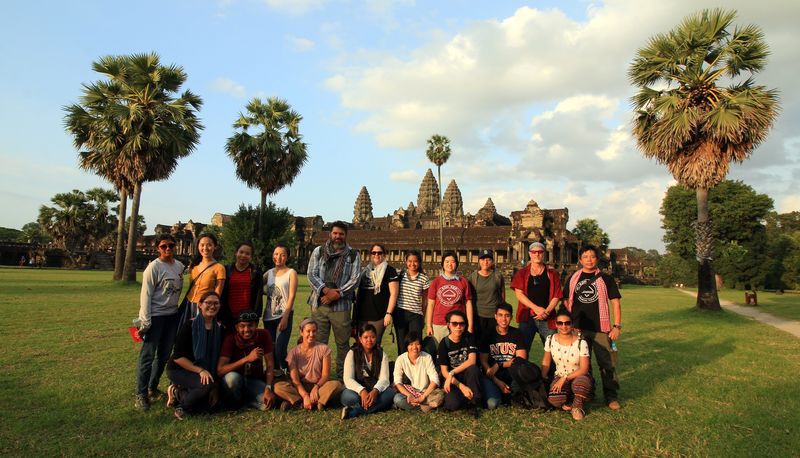
The 2017 field school cohort at Angkor Wat. (Credit: Dr. Ea Darith).
The Archaeology Unit (AU) at ISEAS – Yusof Ishak Institute (ISEAS) in collaboration with Cambodia’s APSARA Authority conducted an archaeological Field School from 28 July – 16 August at the Tonle Snguot site, located near famed Angkor Thom complex near Siem Reap, Cambodia. This session was the fifth Field School conducted by NSC in Cambodia. The Tonle Snguot site is one of close to 100 late Angkorian public hospital complexes that were commissioned under the reign of Mahayana Buddhist King, Jayavarman VII (1181-1218 CE). Major discoveries included a 2.0 metre Dvarapala statue (guardian); a Bhaisjyaguru statue (Medicine/Healing Buddha), a Surya- or Candra-Vairocana statue (Sun or Moon Boddhisattva), and a rich archaeological assemblage dominated by 12th-14th century ceramics.
There were a total of 14 students who participated in the Field School from a variety of East Asian Summit (EAS) countries including Australia; Cambodia; China; India; Indonesia; the Philippines; Thailand; Vietnam; and the United States of America.
The itinerary featured interactive site visits and informal site lectures. Hands-on training sessions took participants and staff through 2000 years of complex socio-political and economic evolution. Topics also included urbanisation, exchange dynamics, cultural influence, and multi-directional agency among pan-Asian networks. The pivotal points of analytical foci and departure spanned the famed Khmer polities of Funan (1st-6th centuries CE), Chenla (7th-8th centuries CE), and Angkor (9th-14th centuries CE).
The main event included the coordinated archaeological and anthropological operations at Tonle Snguot site, a 12th/13th century hospital / chapel complex associated with Jayavarman VII. Efforts will build upon previous studies of similar sties and general themes of urbanism, industries (such as the medical industry), settlement, and specialized site activities. The final Field School leg in Singapore provided an important comparative component, added training opportunities, facilitated library access and allowed participants to finalise and present team projects. Forthcoming results will provide valuable contributions to science, archaeology and history.
Dr. D. Kyle Latinis (Field School Director) and Dr. Ea Darith (Field School Co-Director; APSARA Authority) designed and implemented the project with funding provided by the Ministry of Foreign Affairs, Singapore as part of an EAS initiative. Primary institutions included ISEAS and APSARA Authority. Supporting partners included the Ministry of Culture and Fine Arts, Cambodia; the Royal University of Fine Arts, Cambodia; the Hungarian Southeast Asian Research Institute; and an extensive list of other organisations and independent researchers who provided invaluable input, advice, opportunities and field assistance. Equally important, local communities were actively involved in the research and training. Our sincere gratitude is extended to all contributors.
2017 Field School Administrative History
2017 Archaeological Field School Announcement E-flyer (PDF, 490kb)
2017 Archaeological Field School Booklet (PDF, 3.59mb)
2017 Archaeological Field School Application Form (.doc, 213kb)
2017 Archaeological Field School Frequently Asked Questions (PDF, 423kb)
Image Gallery
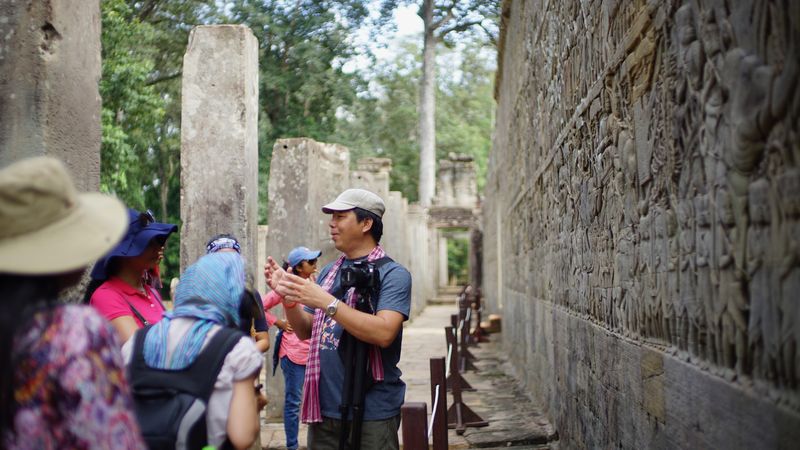
Dr. Ea Darith (Field School Co-Director; APSARA Authority) explaining reliefs at Bayon temple. (Credit: D. Kyle Latinis)
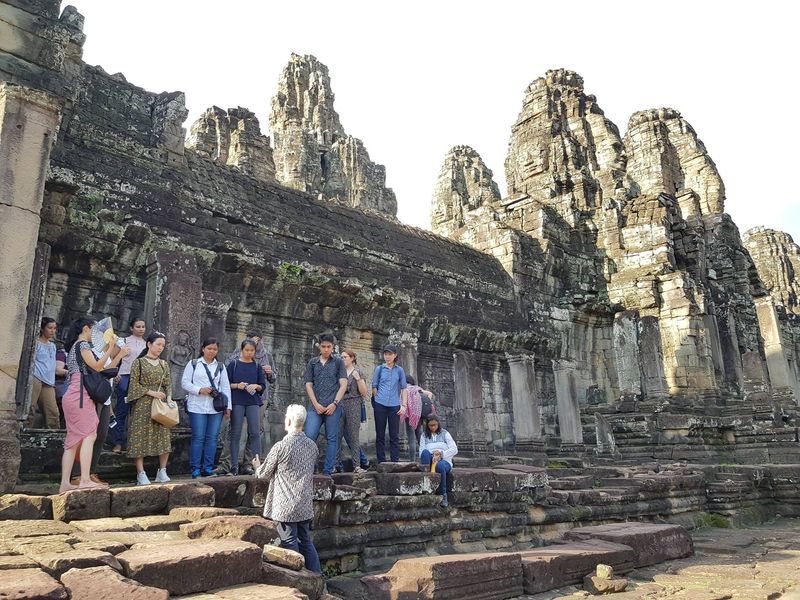
Dr. D. Kyle Latinis (Field School Director; ISEAS – Yusof Ishak Institute) briefed participants on possible ancient hospital structures on reliefs at the Bayon. (Credit: S. T. Foo)
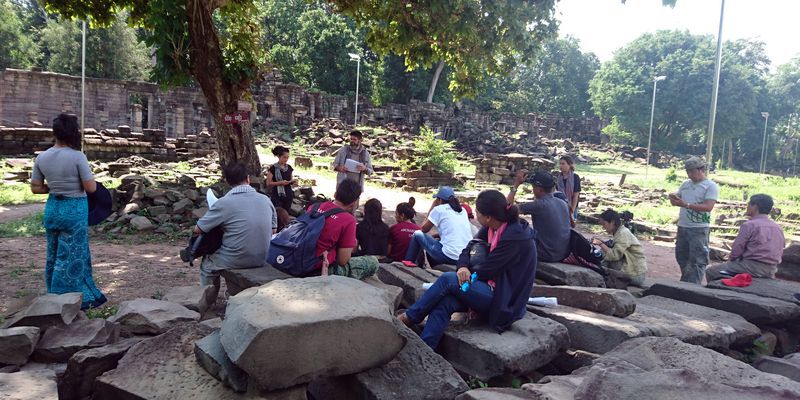
Dr. Hélène Njoto (ISEAS – Yusof Ishak Institute) conducted an art history workshop at Banteay Chhmar with the assistance of Dr. Károly Belényesy (HISTORIARCH – HUNINCO) during a fieldtrip on Angkorian road networks led by Mr. Im Sokrithy (APSARA Authority) and H.E. Dr. Tan Boun Suy (APSARA Authority). (Credit: D. Kyle Latinis)
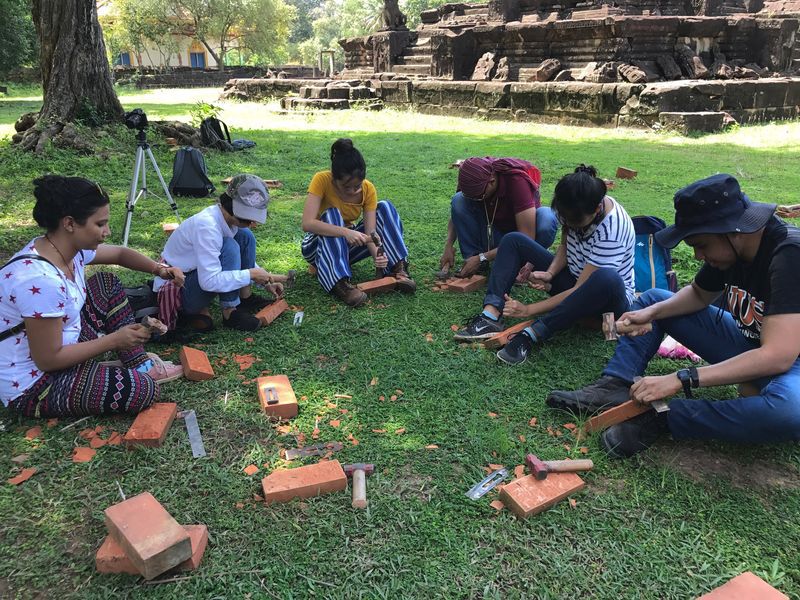
Field school participants took part in a brick temple conservation workshop at Bakong temple by APSARA Authority. (Credit: Chan Wai Peng)
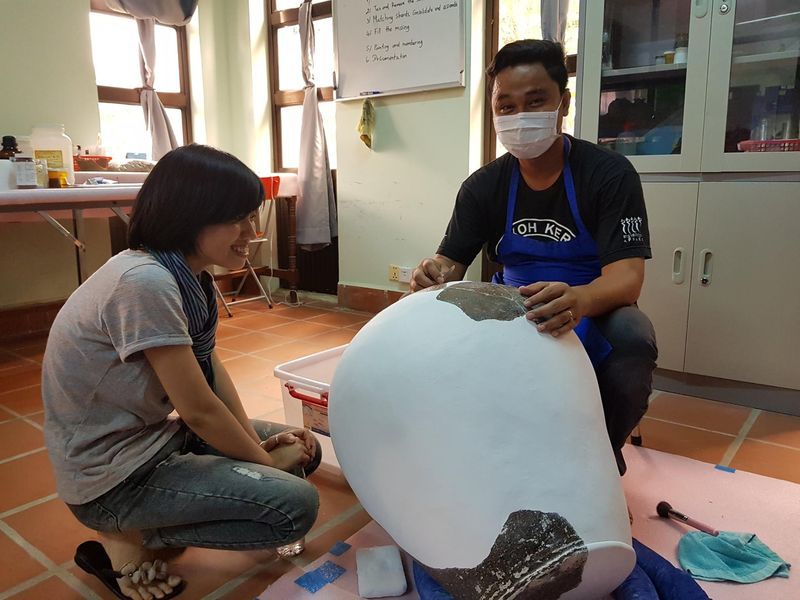
Field school participants learned about ceramic analysis and conservation at APSARA Authority. (Credit: S. T. Foo)
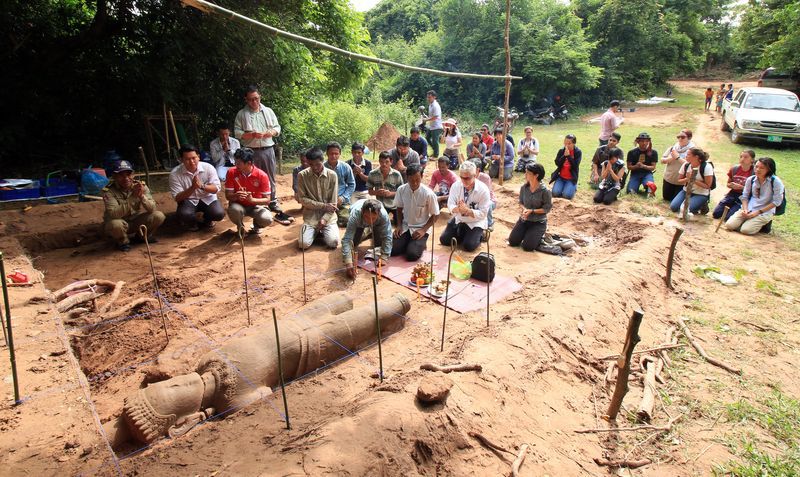
During excavations, a 2.0 metre guardian statue was found (likely in situ). The finds were documented and a small ceremony was conducted in accordance to local customs prior to the removal of the statue for safekeeping by the authorities. (Credit: Dr. Ea Darith)
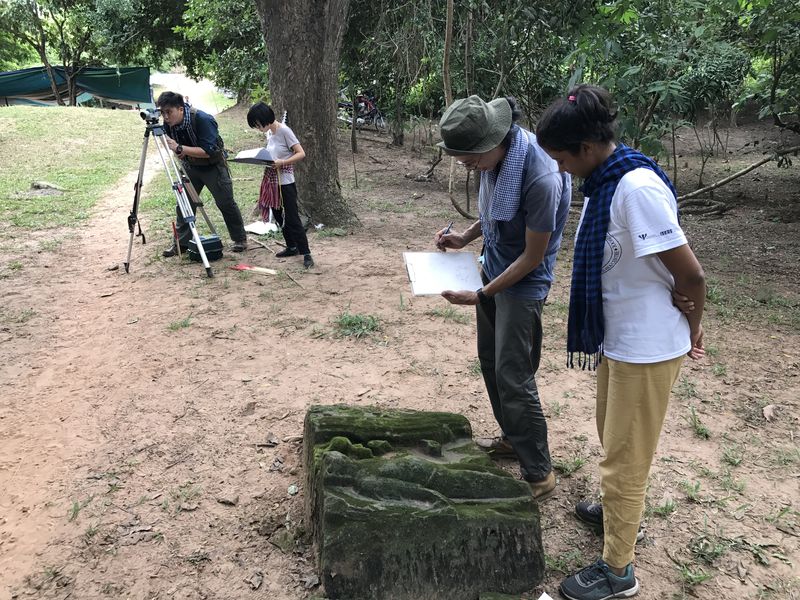
Mr. Michael Ng and Mr. Aaron Kao (ISEAS – Yusof Ishak Institute) conducted survey and drawing training for the field school students. (Credit: Chan Wai Peng)
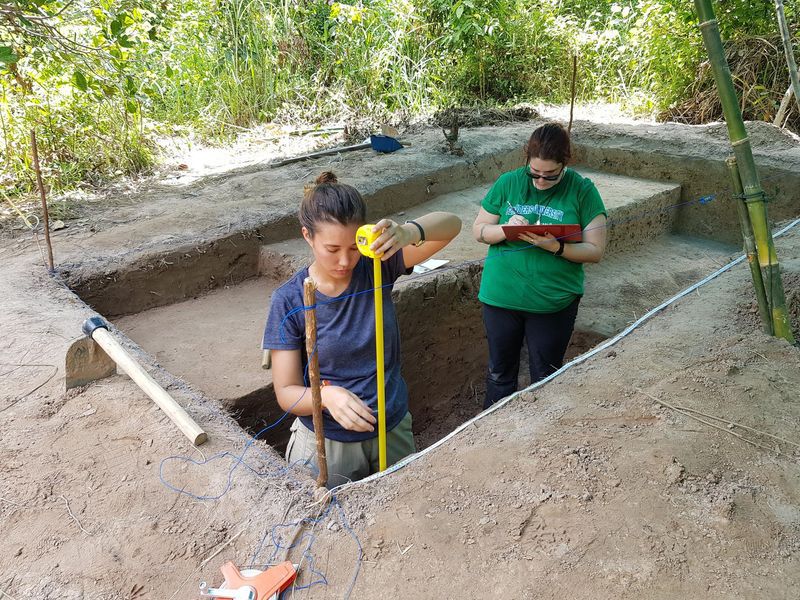
Field participants drawing stratigraphic profiles at Tonle Snguot. (Credit: S. T. Foo)
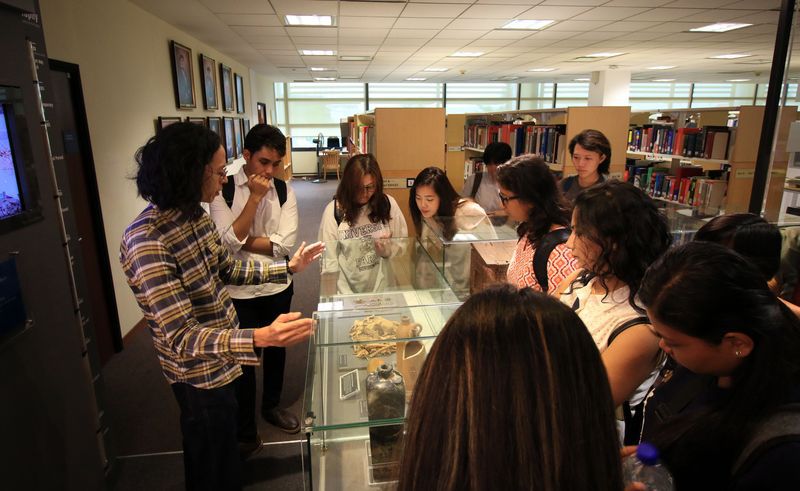
Mr. Aaron Kao (ISEAS – Yusof Ishak Institute) briefed participants on finds displayed in the Archaeology gallery, ISEAS library. The ISEAS library is open to the public and contained finds from excavations in Singapore and from collaborative efforts in Cambodia. (Credit: Ea Darith)
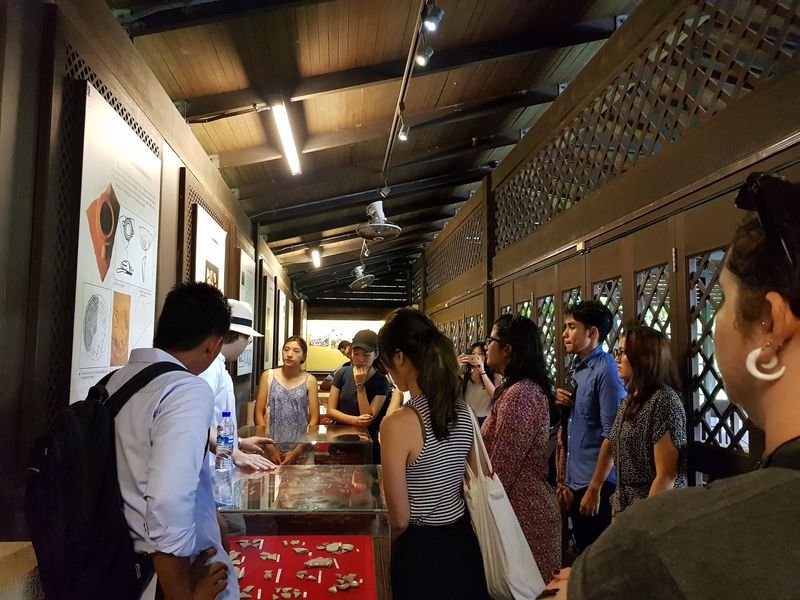
Mr. Lim Chen Sian (ISEAS – Yusof Ishak Institute) briefed participants on the various archaeological finds at Fort Canning. (Credit: S. T. Foo)
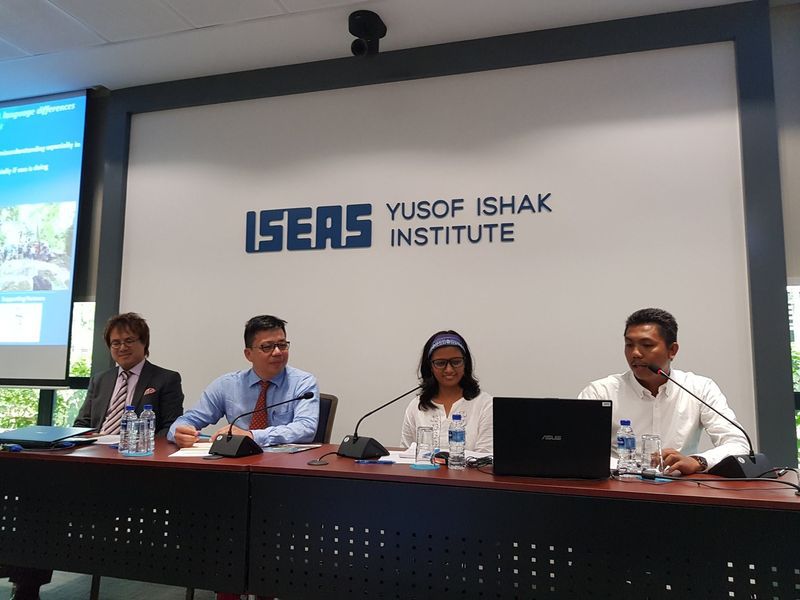
The field school participants gave presentations at the ISEAS – Yusof Ishak Institute, which was moderated by Dr. Ea Darith (Field School Co-Director, APSARA Authority) and Mr. Lim Chen Sian (ISEAS – Yusof Ishak Institute). (Credit: S. T. Foo)

Dr Tana Li is Visiting Senior Fellow at NSC. She is currently a senior fellow at the College of Asia and Pacific Studies, the Australian National University. She is interested in maritime and environmental histories of Vietnam and southern China, from the 2nd BCE to the late 19th centuries. Her works includes The Nguyen Cochinchina (SEAP, Cornell 1998); Water Frontier: Commerce and the Chinese in the Lower Mekong Region, 1750-1880 (co-ed with Cooke, 2004), Gulf of Tongking Through History (Co-ed. with Cooke and Anderson, 2011), and Anthony Reid and the Study of the Southeast Asian Past (Co-ed with Geoff Wade, ISEAS, 2012). Since 2010, Li Tana has developed interests in environmental history of Vietnam and has been a CI of two Australia Research Council Linkage Grants, on “Southeast Asia’s global economy, climate and the impact of natural hazards from the 10th to 21st centuries” (2010-2013), and “Hazards, Tipping Points, Adaptation and Collapse in the Indo-Pacific World” (2015-2019). Both projects are led by James Warren of Murdoch University. In ISEAS, Dr Li will be working on a manuscript about the maritime history of Vietnam. She will also devote time in leading an international collaborative project, “The Making of the Red River”, which is financially supported by the Chiang Chingkuo Foundation, Taiwan. This study of the ecological history of the Greater Red River region is carried out by a team of historians, geologists, and GIS experts based in Austria, France, Vietnam, and Taiwan.
Email: tana_li@iseas.edu.sg
Tel.: 68704559
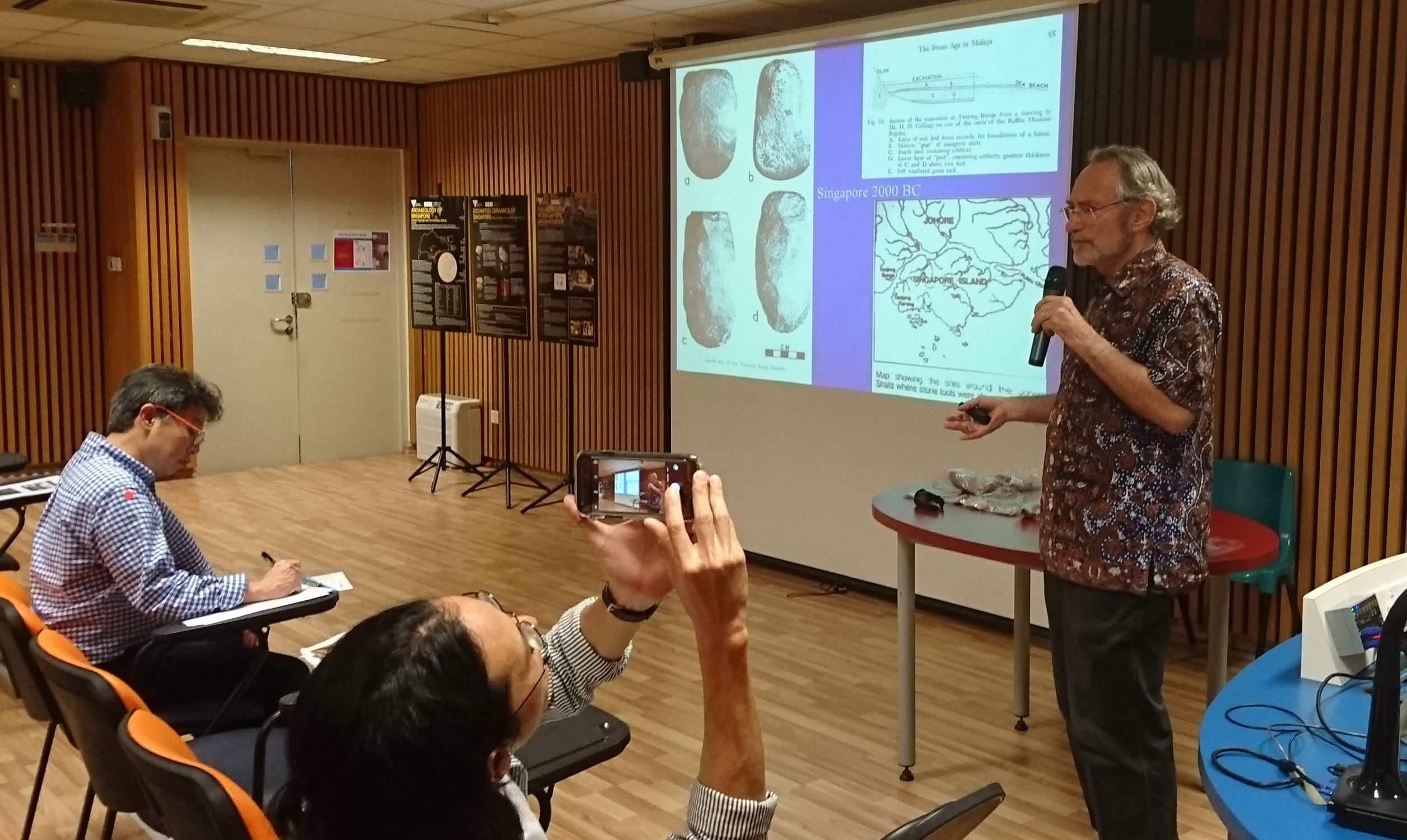
Discussions ranged from ghost stories, rare finds, myth-busting, validating obscure historical references with facts gleaned from new archaeological discoveries, and the large amount of artefacts recovered from Singaporean sites dating to the 14th century. Singaporean archaeologists are now analysing thousands of artefacts. This will offer a significantly enriched understanding of life patterns on the island and global connectedness for over 700 years.
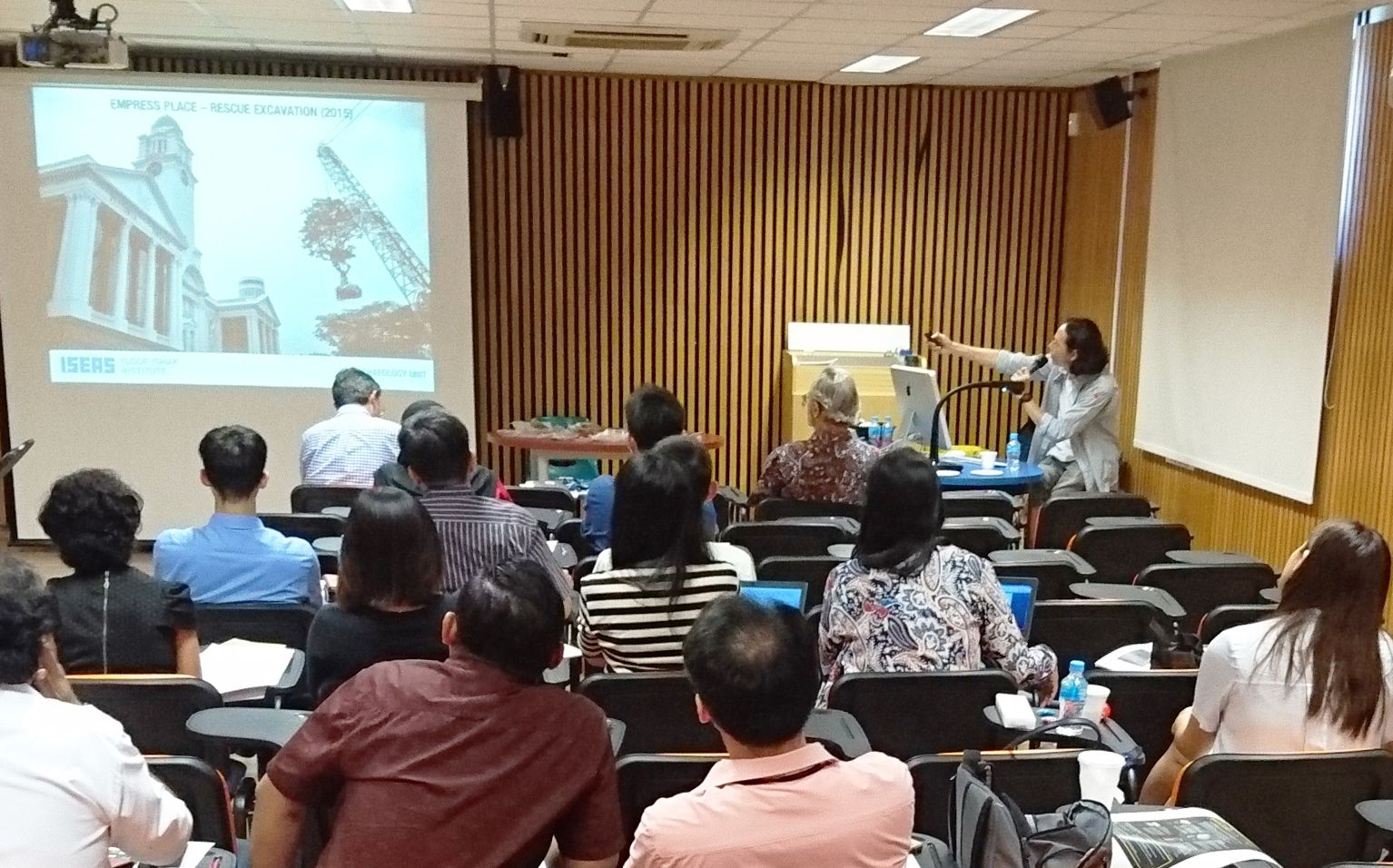
One point that was stressed during the workshop was that archaeology was not a field which proved or disproved history. Rather, the discipline is considered a historical science that focuses on the material remains and long-term impact of past societies. In short, archaeology provides a material perspective to complement history.
Who are we?
We are the Archaeology Unit (AU) at the Nalanda-Sriwijaya Centre (NSC), ISEAS – Yusof-Ishak Institute. The AU is Singapore’s sole national level agency with a dedicated professional archaeology team. ISEAS – Yusof Ishak Institute is a statutory board under the Ministry of Education. The AU is responsible for excavations in Singapore and runs several outreach programmes for schools and government agencies.
One of AU’s missions is to generate awareness and interest on archaeology as a field of study through our Archaeology Programme for Students (APS). APS aims to expose students and teachers to archaeology and show how it contributes to the understanding of Singapore’s past culture and society.
What do we do?
Archaeology is the study of human activity through the recovery and analysis of material culture. Archaeology, like any social science, requires researchers to collect data. To do so the archaeologist would need to conduct fieldwork to meticulously excavate, record and collect artefacts. Once the excavation is completed, the artefacts are transferred to the archaeological laboratory to undergo processing. This process consists of the cleaning, sorting, and cataloguing of the finds. It is only through this process that knowledge and discussion can be generated.
The Archaeology Programme for Students is now part of Temasek History Research Centre. Please click here for more information.
Beyond research and publications, the Nalanda-Sriwijaya Centre (NSC) is committed to public outreach activities. Such activities promote the importance of Southeast Asia’s premodern history, as well as the pivotal role played by archaeology and history in recovering such histories. For this purpose, the centre and the Archaeology Unit (AU) have been active in organising Field Schools, student programmes, workshops and conferences, and publishing NSC Highlights, among others.
Partnering various agencies, a few examples of NSC’s public outreach include:
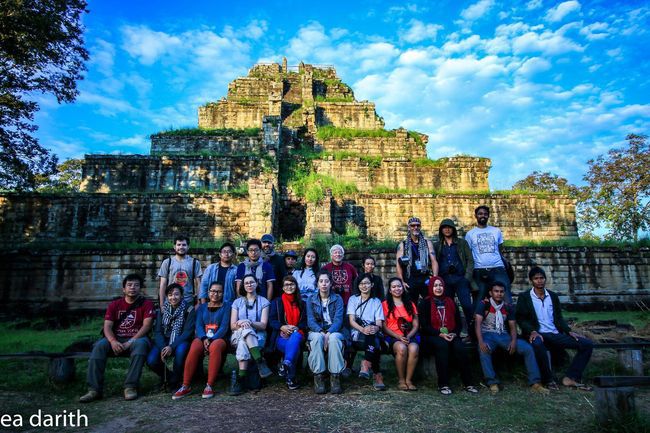
The 2016 Archaeological Field School at Prasat Thom, Koh Ker, Preah Vihear province, Cambodia.
(Credit: Dr. Ea Darith)
There were a total of 16 students who participated in the Field School from a variety of East Asian Summit countries including Australia; Cambodia; China; India; ; Indonesia; Malaysia; New Zealand; the Philippines; Singapore; Thailand; and Vietnam.
The itinerary featured interactive site visits and informal on-site lectures. Hands-on training sessions took participants and staff through 2000 years of complex socio-political and economic evolution. Topics also included urbanisation, exchange dynamics, cultural influence, and multi-directional agency among pan-Asian networks. The pivotal points of analytical foci and departure spanned the famed Khmer polities of Funan (1st-6th centuries CE), Chenla (7th-8th centuries CE), and Angkor (9th-14th centuries CE).
The main event included the coordinated archaeological and anthropological operations at multiple sites within the enigmatic 10th century Angkorian capital city of Koh Ker associated with the reign of Jayavarman IV. The field school was designed to complement ongoing efforts and build on the results of the 2015 field season. Participants lived on-site (in the forest) working with professional staff and local community members. They trained at several excavation locales to cover a diverse range of approaches, techniques and research questions. The results will provide valuable contributions to science, archaeology and history.
The final Field School leg in Singapore provided an important comparative component, added training opportunities, facilitated library access and allowed participants to finalise and present team projects. The Field School was funded by the Ministry of Foreign Affairs, Singapore. Primary institutions included ISEAS, APSARA Authority, and the National Authority for Preah Vihear. Supporting partners included the Ministry of Culture and Fine Arts, Cambodia; the Royal University of Fine Arts, Cambodia; The Royal Academy of Cambodia; the National Museum of Cambodia; the Hungarian Southeast Asian Research Institute; Ecole Française d’Extreme-Orient; and an extensive list of several other organisations and independent researchers who provided invaluable input, advice, opportunities and support.
2016 Field School Administrative History
2016 Archaeological Field School Announcement E-flyer (PDF, 450kb)
2016 Archaeological Field School Booklet (PDF, 2.42MB)
2016 Archaeological Field School Application Form (.doc, 211kb) (due 22 July 2016 +8GMT)
2016 Archaeological Field School Frequently Asked Questions (PDF, 333kb – updated 29 April 2016)
Image Gallery
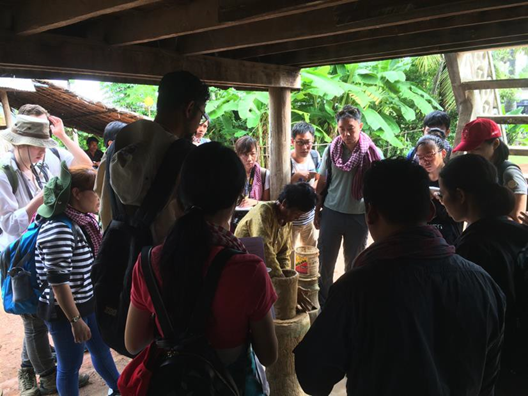
Learning about traditional pottery making at a Kampong Chhnang potting village, led by Mr. Tep Sokha. (Credit: D. Kyle Latinis)
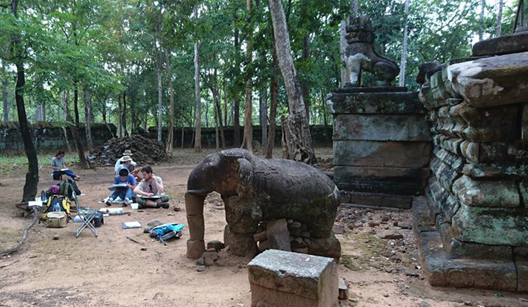
Drawing class at Prasat Damrei led by Aaron Kao (NSC). (Credit: D. Kyle Latinis)
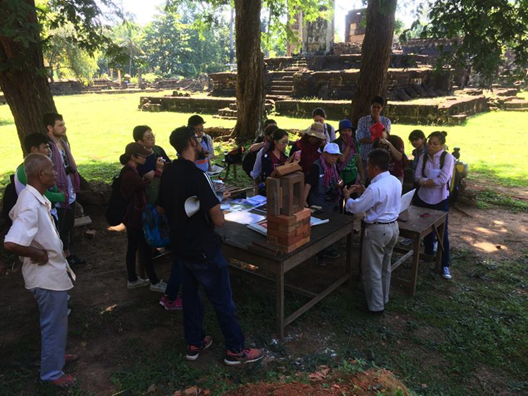
Conservation and restoration workshop with APSARA National Authority at 9th century Bakong Temple – using traditional bricks, mortar, sandstone, and construction technology. (Credit: D. Kyle Latinis)
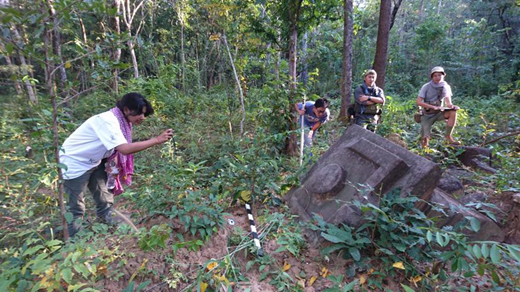
Mapping exercise with Michael Ng and Aaron Kao (NSC) at Prasat Andong Kuk. (Credit: D. Kyle Latinis)
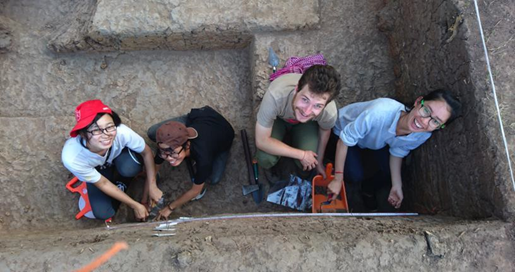
Practicing profile drawings at the KK2 Habitation/Household Site. (Credit: D. Kyle Latinis)
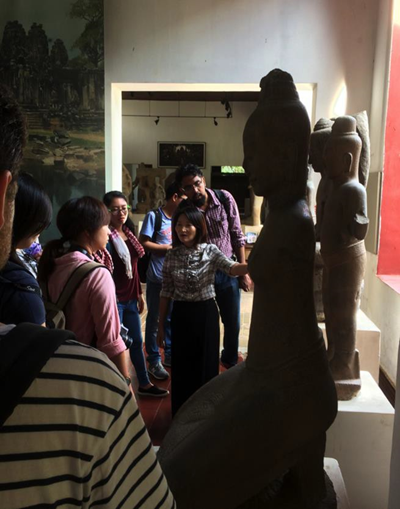
Field school participants had the opportunity to visit and learn from the National Museum of Cambodia staff in Phnom Penh. (Credit: D. Kyle Latinis)
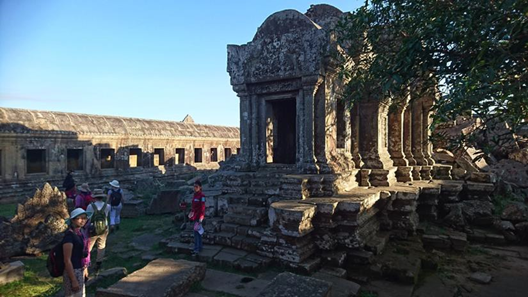
Field school participants visited Preah Vihear temple, guided by Preah Vihear authority staff. (Credit: D. Kyle Latinis)
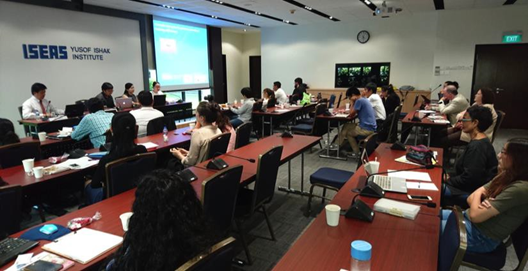
The field school activities culminated in presentations at the ISEAS – Yusof Ishak Institute, Singapore. (Credit: D. Kyle Latinis)
This publication presents the main categories of the numerous finds from the Belitung wreck and provides their historical frame.

Photo collage by Rinkoo Bhowmik
ESSAYS
Page no.
CATALOGUE
Gold, Silver and Bronze (François Louis)
| 132 | Gold and Silver – [Introduction]; [Catalogue] |
| 192 | Tang Bronze Mirrors – [Introduction]; [Catalogue] |
| 224 | The Coins |
Ceramics
| 228 | White Ware with Green Décor (Hsieh Mingliang) – [Introduction]; [Catalogue] |
| 300 | White Wares of Northern China (Regina Krahl) – [Introduction]; [Catalogue] |
| 350 | Green Wares of Southern China (Regina Krahl) – [Introduction]; [Catalogue] |
| 464 | Changsha Ware (Liu Yang) – [Introduction]; [Catalogue 1]; [Catalogue 2] |
| 640 | Various Ceramics (Chen Yuh-Shiow) – [Catalogue] |
| 656 | MISCELLANEOUS ARTEFACTS (Michael Flecker) |
APPENDICES
Click here to download Appendix I-VI
| 708- 725 |
Appendix I Changsha Bowls |
| 1. Designs | |
| 2. Inscriptions | |
| Appendix II Changsha Cups: Designs | |
| Appendix III Ewers | |
| 1. Medallions on Ewers | |
| 2. Inscriptions on Ewers | |
| Appendix IV Jars: Appliqués and Inscriptions | |
| Appendix V Yue Wares: Designs | |
| Appendix VI Ceramic Forms |
| 740 | CHINESE NAMES AND TERMS |
| 744 | BIBLIOGRAPHY |
| 755 | INDEX |
Publication details: Copyright © 2004, Seabed Explorations New Zealand Ltd. All rights reserved.
Individual papers can be downloaded below. However, if you wish to download the complete set in one pdf file, please click here (Note: because of file compression, photos in this combined file may have lower resolution than the individual files below).
Imagining Asia(s): Networks, Actors, Sites
• When does the idea of Asia (and regions) come into being and how far back in time can we trace these spatial imagination(s)?
• What are the registers of inter-Asian connections?
• What are the logistical aspects governing the routes—overland and maritime—that linked up different regions of Asia?
• Who fashions themselves as Asians and in what context and location?
• What roles did imperial formations (old and new, European and non-European) play in shaping Asia?
• Do ideas of nationalism and post-colonial nation states fracture Asia?
• Does the post-colonial state or elites privilege specific Asian identities over others for their own interests?
• What are the current geopolitical forces that help maintain the neatly defined regional configurations in Asia?
Conveners:
Andrea Acri (NSC & Nalanda University), Kashshaf Ghani (Nalanda University), Murari Jha (Nalanda University), Sraman Mukherhee (Nalanda University).
Venue and dates:
ISEAS–Yusof Ishak Institute, Singapore, 10–11 October 2016
Deadline for abstract submission:
Please send an abstract of between 200–250 words max, along with a short biodata, to both nscconferences@iseas.edu.sg and conferences@nalandauniv.edu.in by 1 April, 2016 (5 pm. Singapore Time, +8 hours GMT).
Notification of Acceptance:
By 17 April 2016.
Funding:
ISEAS–Yusof Ishak Institute will cover accommodation and full board in Singapore for the conference participants from overseas. Limited funding is available to cover international flights (fully or partially, depending on the place of departure and individual situation).
Deliverables:
Selected conference papers will be published in an edited volume.



